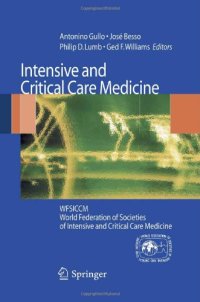
Ebook: Intensive and Critical Care Medicine: WFSICCM World Federation of Societies of Intensive and Critical Care Medicine
Author: G. Ristagno M. H. Weil (auth.) Antonino Gullo Philip D. Lumb José Besso Ged F. Williams (eds.)
- Tags: Intensive / Critical Care Medicine, Anesthesiology, Emergency Medicine, Surgery
- Year: 2009
- Publisher: Springer-Verlag Mailand
- Edition: 1
- Language: English
- pdf
The focus of this volume endorsed by World Federation of Societies on Intensive and Critical Care Medicine is the "state of the art" of Intensive and Critical Care Medicine as well as new insights into basic science, clinical research and therapeutic interventions. Structured in four parts, the volume opens with few chapters devoted to the beginning and development of the WSICCM, to procedures standardization, recommendations and quality of care improvement, with particular reference to the definition of clinical governance, professionalism and ethics. In the second part, the authors describe the practical clinical approach to critical illness; among the topics dealt with, the reader will find monitoring and management of shock states; acute pain management, airway management, ALI/ARDS and protective lung ventilation; the problem of weaning; antibiotics policy, sepsis and organ dysfunction. The third part of the book is related to some special conditions of countries with limited resources, such as management of obstetrics at high risk, malaria; AIDS, blood transfusion and its components. The last part of the book is structured to present some crucial issues of the intensive and critical care arena, in particular evidence-based practice, the role of the e-distance learning for information and the promotion of CME programs; last but not least, trauma care, disaster and natural disaster medicine are also discussed; a final chapter on the Guidelines of the World Health Organization (WHO) on Disaster Medicine is included.
Comprehensive though easy-to-consult, updated and written by world-renowned experts, the volume will be a very useful tool in the daily practice of all health professionals working in the intensive and critical care environment.
The focus of this volume is the "state of the art" of Intensive and Critical Care Medicine as well as new insights into basic science, clinical research and therapeutic interventions. Structured in four parts, the volume opens with few chapters devoted to the beginning and development of the WSICCM, to procedures standardization, recommendations and quality of care improvement, with particular reference to the definition of clinical governance, professionalism and ethics. In the second part, the authors describe the practical clinical approach to critical illness; among the topics dealt with, the reader will find monitoring and management of shock states; acute pain management, airway management, ALI/ARDS and protective lung ventilation; the problem of weaning; antibiotics policy, sepsis and organ dysfunction. The third part of the book is related to some special conditions of countries with limited resources, such as management of obstetrics at high risk, malaria, AIDS, blood transfusion and its components. The last part of the book is structured to present some crucial issues of the intensive and critical care arena, in particular evidence-based practice, the role of the e-distance learning for information and the promotion of CME programs; last but not least, trauma care, disaster and natural disaster medicine are also discussed; a final chapter on the Guidelines of the World Health Organization (WHO) on Disaster Medicine is included.